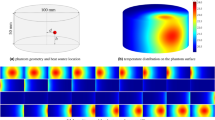Abstract
In the recent scenario, there are various methods for imaging the human body for medical diagnostics, viz. X-ray radiology, magnetic resonance imaging (MRI), ultrasound, computerized axial tomography (CAT), positron emission tomography (PET) scanning, etc. Imaging the human body using IR is non-invasive as it is not ionizing in the tissue, nevertheless, it suffers from the limitation of less penetration power in the tissue and poor resolution. Thermal imaging is one of the imaging techniques, which has shown a promising result in the diagnosis of cancer. The use of thermal radiations for cancer diagnosis is safe as compared to many other imaging modalities. With the advancements in image processing routines, it has become feasible to make use of non-invasive nature of thermal radiations for cancer diagnosis. The time for the capturing of thermal image, pre-processing, and analysis of image data has improved from last few decades with recent advancements in sensor technology and analysis tools. Thus, it has become an important task to remove noise from the thermal image and restore a high-quality image in order for better thermographic assessment of images. This paper presents the denoising of thermal images using deep neural network by adding the different types of the noises to the original thermal image. The quantitative analysis is done using the three metrices which are peak signal to noise ratio, structural similarity index measurement, and mean square error in which the deep neural network shows a promising result and remove a lot of Gaussian noise and also improve the image quality than normal filtering techniques.
Access this chapter
Tax calculation will be finalised at checkout
Purchases are for personal use only
Similar content being viewed by others
References
Lipari, CA, Head JF(1997) Advanced infrared image processing for breast cancer risk assessment. In: Proceedings of the 19th annual international conference of the IEEE engineering in medicine and biology society. ‘magnificent milestones and emerging opportunities in medical engineering'(Cat. No. 97CH36136), vol 2, ppp 673–676. IEEE
Tomohiro, KS, Onodera JI (2001) United nations scientific committee on the effects of atomic radiation 2000 report. Jap J Health Phys 36(2):149–158
Zhou Y, Chen J, Li Q, Huang W, Lan H, Jiang H (2015) Association between breastfeeding and breast cancer risk: evidence from a meta-analysis. Breastfeed Med 10(3):175–182
Gram IT, Bremnes Y, Ursin G, Maskarinec G, Bjurstam N, Lund NE (2005) Percentage density, Wolfe's and Tabar's mammographic patterns: agreement and association with risk factors for breast cancer. Breast Cancer Res 7(5):R854
Michaelson JS, Silverstein M, Wyatt J, Weber G, Moore R, Halpern E, Kopans DB, Hughes K (2002) Predicting the survival of patients with breast carcinoma using tumor size. Cancer: Interdisciplinary Int J Am Cancer Soc 95(4)):713–723
Liu Z, Yan WQ, Yang ML (2018) Image denoising based on a CNN model. In:2018 4th International conference on control, automation and robotics (ICCAR), pp.389–393. IEEE
He Y, Li X, Li R, Wang J, **g X (2020) A Deep-Learning Method for Radar Micro-Doppler Spectrogram Restoration. Sensors 20(17):5007
AlHajjar B (2013) Occupational stress among hospital nurses in Gaza-Palestine. University of Manchester
Thukral R, Kumar A, Arora AS, Gulshan (2019) Effect of different thresholding techniques for denoising of EMG signals by using different wavelets. In: 2019 2nd International conference on intelligent communication and computational techniques (ICCT), 2019, pp 161–165. https://doi.org/10.1109/ICCT46177.2019.8969036
Ganesh L, Chaitanya SK, Rao JD, Kumar MNVSS (2014) Development of image fusion algorithm for impulse noise removal in digital images using the quality assessment in spatial domain. International Journal of Engineering Research and Applications (IJERA) 1:786–792
Singh P, Shankar A (2021) A novel optical image denoising technique using convolutional neural network and anisotropic diffusion for real-time surveillance applications. J Real-Time Image Proc 1–18
Singh AP, Kamal TS, Kumar S (2006) Development of a virtual linearizer for correcting transducer static nonlinearity. ISA Trans 45(3):319–328
Sezan MI, Lagendijk RL (eds) (2012) Motion analysis and image sequence processing (Vol 220). Springer Science & Business Media
Singh P, Shree R (2020) A new homomorphic and method noise thresholding based despeckling of SAR image using anisotropic diffusion. J King Saud Univ Comput Inf Sci 32(1):137–148
Chakre R, Thapa P, Siddharth R, Baruah U (2013) An experimental study on image de-noising filters. Int J Emerging Technol Adv Eng 3(2):549–553
Lee D et al (2015) Learning speed improvement using multi-GPUs on DNN-Based acoustic model training in Korean Intelligent personal assistant. In: Natural language dialog systems and intelligent assistants. Springer, Cham, pp 263–271
Singh P, Shree R (2017) A new homomorphic and method noise thresholding based despeckling of SAR image using anisotropic diffusion. J King Saud Univ Comput Inf Sci
Singh P, Shree R (2016) Statistical modelling of log transformed speckled image. Int J Comput Sci Inf Secur (IJCSIS). 14(8)
Singh P, Shree R (2018) A new SAR image despeckling using directional smoothing filter and method noise thresholding. Eng Sci Tech Int J
Singh P et al (2018) A new SAR image despeckling using correlation-based fusion and method noise thresholding. J King Saud Univ Comput Inf Sci
Author information
Authors and Affiliations
Editor information
Editors and Affiliations
Rights and permissions
Copyright information
© 2022 The Author(s), under exclusive license to Springer Nature Singapore Pte Ltd.
About this paper
Cite this paper
Thukral, R., Arora, A.S., Kumar, A., Gulshan (2022). Denoising of Thermal Images Using Deep Neural Network. In: Mahapatra, R.P., Peddoju, S.K., Roy, S., Parwekar, P., Goel, L. (eds) Proceedings of International Conference on Recent Trends in Computing . Lecture Notes in Networks and Systems, vol 341. Springer, Singapore. https://doi.org/10.1007/978-981-16-7118-0_70
Download citation
DOI: https://doi.org/10.1007/978-981-16-7118-0_70
Published:
Publisher Name: Springer, Singapore
Print ISBN: 978-981-16-7117-3
Online ISBN: 978-981-16-7118-0
eBook Packages: Intelligent Technologies and RoboticsIntelligent Technologies and Robotics (R0)




